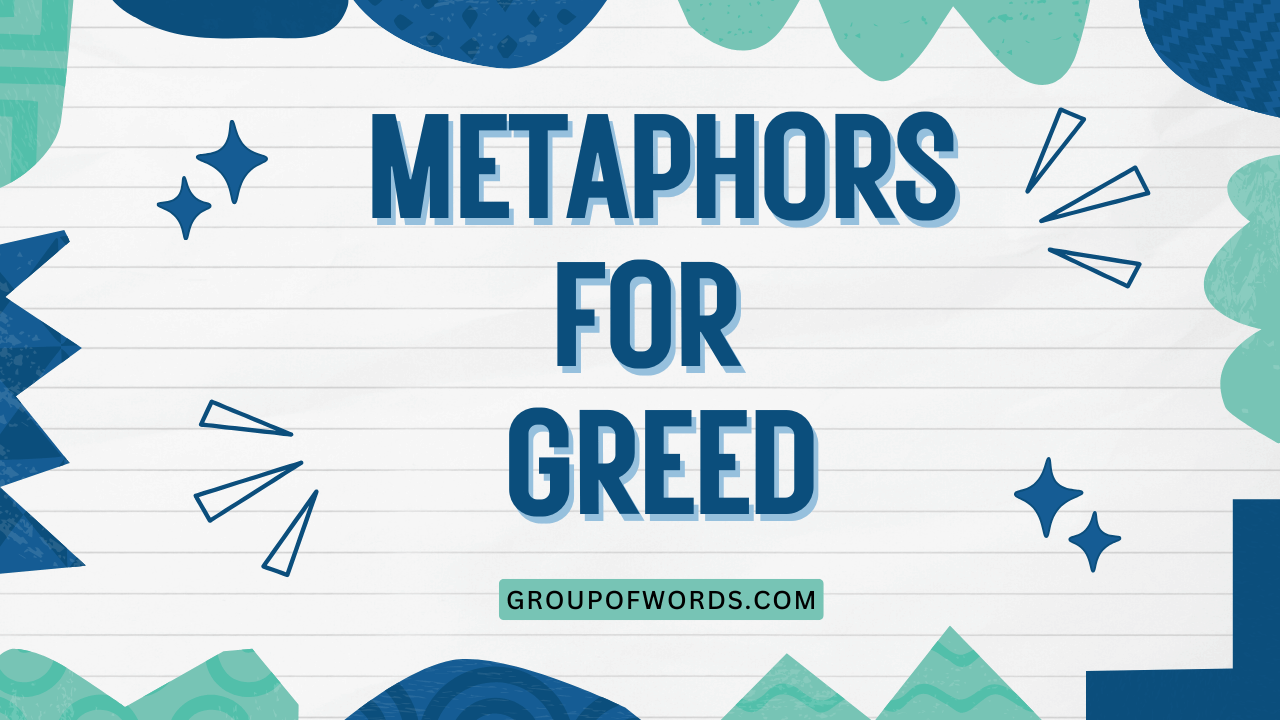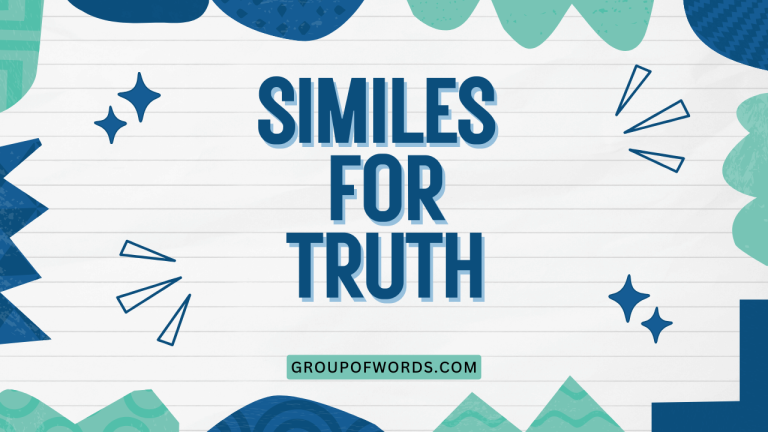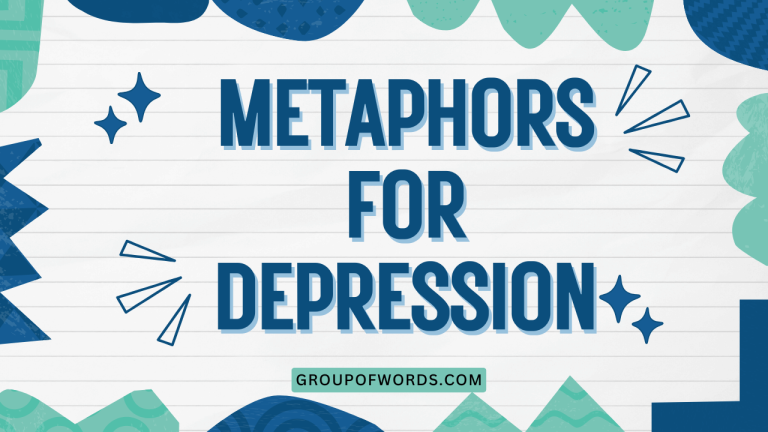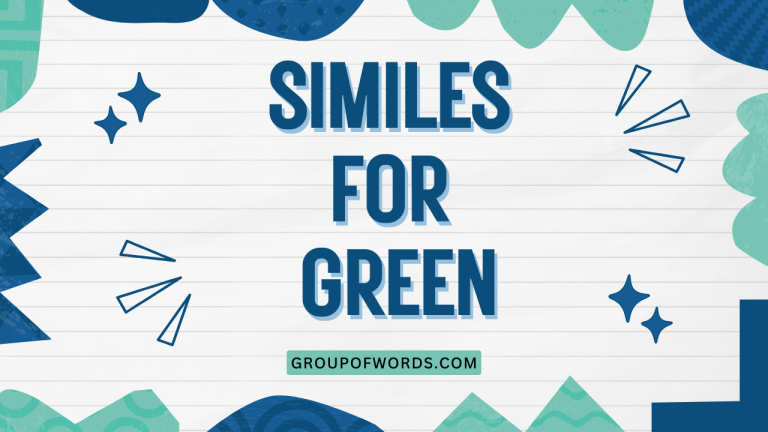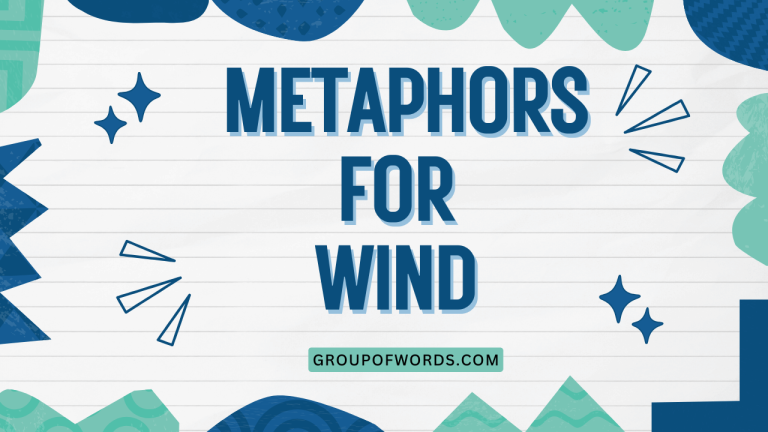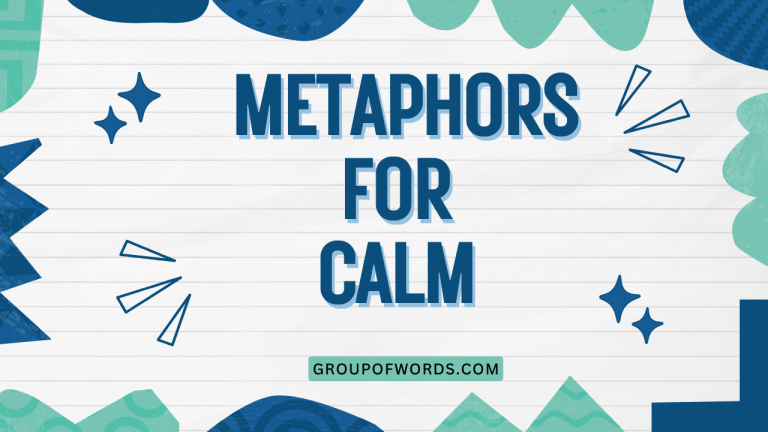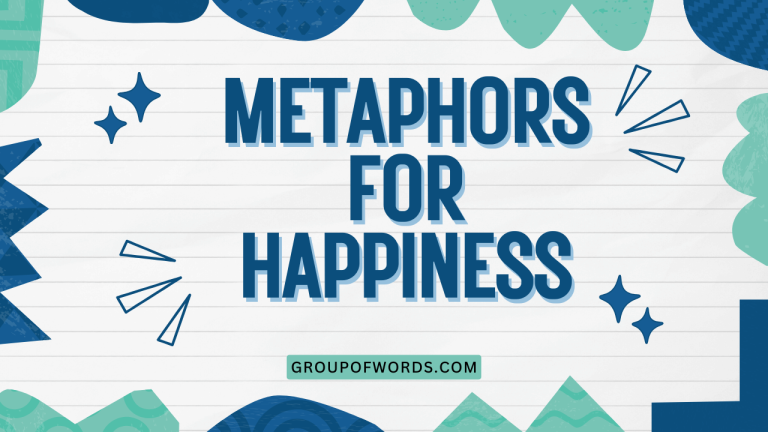Greed: Metaphors Unveiled in English Grammar
Understanding how greed is portrayed through metaphors is crucial for mastering figurative language and enriching communication. Metaphors transform abstract concepts like greed into tangible images, making them more vivid and relatable.
This article explores various metaphors for greed, providing a comprehensive guide for students, writers, and anyone interested in enhancing their understanding of English grammar and expressive language. By examining different types of metaphors and their usage, you’ll gain the ability to recognize and employ these powerful literary devices effectively.
This guide covers the definition, structural breakdown, types, and usage rules of metaphors for greed. We’ll also address common mistakes and provide practice exercises to solidify your understanding.
Whether you’re an ESL learner or a native speaker, this resource will sharpen your ability to interpret and create compelling metaphors, adding depth and nuance to your writing and conversation.
Table of Contents
- Definition of Metaphors for Greed
- Structural Breakdown of Metaphors
- Types and Categories of Metaphors for Greed
- Examples of Metaphors for Greed
- Usage Rules for Metaphors
- Common Mistakes When Using Metaphors
- Practice Exercises
- Advanced Topics in Metaphorical Language
- Frequently Asked Questions
- Conclusion
Definition of Metaphors for Greed
A metaphor is a figure of speech that directly compares two unrelated things without using “like” or “as.” It asserts that one thing *is* another, creating a vivid and often surprising connection. When applied to greed, metaphors serve to illustrate the abstract nature of excessive desire by associating it with more concrete, relatable concepts.
These metaphors can highlight the destructive, insatiable, or dehumanizing aspects of greed.
Metaphors for greed function by transferring qualities from one domain (e.g., hunger, disease) to another (the abstract concept of greed). This transfer allows us to understand and articulate the complex emotional and behavioral components of greed in a more accessible and impactful way.
The context in which a metaphor is used significantly influences its interpretation. For example, describing someone’s greed as a “bottomless pit” evokes a sense of endless, unfulfillable desire.
In English grammar, metaphors are classified as figures of speech and fall under the broader category of figurative language. They are used to add depth, color, and emotional resonance to writing and speech.
Metaphors for greed can be found in literature, journalism, everyday conversation, and even legal discourse, showcasing their versatility and importance in shaping our understanding of this complex human trait.
Structural Breakdown of Metaphors
A metaphor fundamentally consists of two key elements: the tenor and the vehicle. The tenor is the subject to which metaphorical attributes are ascribed (in our case, greed). The vehicle is the object or concept whose attributes are borrowed to describe the tenor. Understanding this structure allows for a more precise interpretation and construction of metaphors.
The relationship between the tenor and vehicle is based on shared characteristics or associations. These shared characteristics are often implicit and require the reader or listener to make a connection between the two.
For example, in the metaphor “greed is a consuming fire,” the tenor is “greed,” and the vehicle is “a consuming fire.” The shared characteristic is the destructive and all-encompassing nature of both greed and fire. Fire spreads and devours everything in its path, mirroring how greed can consume a person’s values and relationships.
Effective metaphors also rely on context. The surrounding words and sentences provide clues that guide the interpretation of the metaphor.
A metaphor that is clear in one context might be confusing or ineffective in another. Therefore, careful consideration of the audience and the overall message is crucial when using metaphors for greed.
Types and Categories of Metaphors for Greed
Metaphors for greed can be categorized based on the type of imagery they evoke. Here are some common categories:
Animalistic Metaphors
These metaphors associate greed with animalistic behaviors, often highlighting the predatory or scavenging nature of excessive desire. They can depict greed as a primal instinct, devoid of empathy or reason.
Animalistic metaphors often portray greed as a relentless, insatiable hunger or a fierce, territorial protectiveness over possessions. The specific animal chosen can further refine the metaphor’s meaning, with some animals suggesting cunning and calculation, while others emphasize brute force and aggression.
Consuming Metaphors
Consuming metaphors depict greed as something that devours or engulfs, often leaving nothing behind. These metaphors emphasize the destructive and insatiable nature of greed, suggesting that it can consume not only material possessions but also moral values and relationships.
These metaphors often use imagery of fire, hunger, or emptiness to portray greed as a force that relentlessly seeks to fill a void, but can never be satisfied. They highlight the self-destructive aspect of greed, as it ultimately consumes the person who is consumed by it.
Disease Metaphors
Disease metaphors portray greed as an illness that infects and corrupts. These metaphors highlight the insidious and debilitating effects of greed, suggesting that it can spread and worsen over time if left unchecked.
Disease metaphors emphasize the contagious and uncontrollable nature of greed, often depicting it as a virus that infects individuals and organizations alike. They also highlight the psychological and emotional toll of greed, suggesting that it can lead to anxiety, paranoia, and a loss of moral compass.
Natural Disaster Metaphors
Natural disaster metaphors compare greed to destructive forces of nature, such as floods, earthquakes, or tornadoes. These metaphors emphasize the overwhelming and devastating impact of greed, suggesting that it can cause widespread destruction and suffering.
These metaphors often portray greed as an uncontrollable force that sweeps away everything in its path, leaving behind a trail of devastation. They highlight the unpredictable and chaotic nature of greed, as well as its potential to cause irreparable damage.
Object-Based Metaphors
Object-based metaphors use tangible objects to represent greed, often highlighting its materialistic and soulless nature. These metaphors can depict greed as a hollow shell, a heavy burden, or a worthless trinket.
These metaphors often use imagery of gold, money, or possessions to portray greed as an obsession with material wealth. They highlight the emptiness and superficiality of greed, suggesting that it ultimately fails to provide lasting satisfaction or fulfillment.
Abstract Metaphors
Abstract metaphors use abstract concepts to represent greed, focusing on its intangible qualities and effects. These metaphors can depict greed as a dark cloud, a bottomless pit, or a twisted knot.
These metaphors often emphasize the psychological and emotional dimensions of greed, highlighting its capacity to distort perceptions, corrupt values, and create internal conflict. They can portray greed as a source of anxiety, paranoia, and a profound sense of emptiness.
Examples of Metaphors for Greed
Here are some examples of metaphors for greed, organized by category. Each table provides a range of examples to illustrate the different ways in which greed can be portrayed metaphorically.
The following table provides examples of animalistic metaphors for greed. These metaphors often associate greed with the predatory or scavenging behaviors of animals, highlighting the ruthless and insatiable nature of excessive desire.
| Metaphor | Explanation |
|---|---|
| His greed was a ravenous wolf, devouring everything in its path. | Greed is likened to a wolf, emphasizing its insatiable hunger and destructive nature. |
| She was a vulture circling the inheritance, waiting to swoop in. | Greed is portrayed as a vulture, highlighting its predatory and opportunistic nature. |
| The company’s greed was a pack of hyenas tearing apart the competition. | Greed is likened to a pack of hyenas, emphasizing its ruthless and competitive nature. |
| His desire for wealth was a snake coiled around his heart, squeezing out compassion. | Greed is portrayed as a snake, highlighting its insidious and constricting effects. |
| They were leeches, sucking the lifeblood out of the company for their own gain. | Greed is likened to leeches, emphasizing its parasitic and exploitative nature. |
| His ambition was a shark, constantly hunting for the next big deal. | Greed is portrayed as a shark, highlighting its relentless pursuit of wealth and power. |
| The politician’s greed was a pig at the trough, gorging itself on public funds. | Greed is likened to a pig, emphasizing its gluttonous and selfish nature. |
| She was a spider spinning a web of deceit to ensnare investors. | Greed is portrayed as a spider, highlighting its cunning and manipulative nature. |
| His lust for power was a lion, roaring and demanding submission. | Greed is likened to a lion, emphasizing its aggressive and domineering nature. |
| The CEO’s greed was a swarm of locusts, stripping the company bare. | Greed is portrayed as a swarm of locusts, highlighting its destructive and all-consuming nature. |
| He guarded his wealth like a dragon hoarding gold in its lair. | Greed is likened to a dragon, emphasizing its possessive and protective nature. |
| Her ambition was a termite, slowly eating away at her moral compass. | Greed is portrayed as a termite, highlighting its insidious and destructive effects. |
| The banker’s greed was a hawk, always watching for opportunities to exploit. | Greed is likened to a hawk, emphasizing its sharp vision and predatory instincts. |
| He was a fox, cunningly maneuvering to gain an advantage. | Greed is portrayed as a fox, highlighting its sly and deceptive nature. |
| Their greed was a rat, scurrying through the shadows to steal what it could. | Greed is likened to a rat, emphasizing its secretive and opportunistic nature. |
| His desire for recognition was a peacock, constantly displaying its feathers. | Greed is portrayed as a peacock, highlighting its vain and attention-seeking nature. |
| The investor’s greed was a bear, aggressively mauling anyone who stood in its way. | Greed is likened to a bear, emphasizing its aggressive and destructive nature. |
| His avarice was a caterpillar, slowly but surely devouring his humanity. | Greed is portrayed as a caterpillar, highlighting its gradual but destructive impact. |
| The politician’s cronies were ticks, latching onto him and sucking him dry. | Greed is likened to ticks, emphasizing its parasitic and exploitative nature. |
| Her relentless pursuit of wealth had turned her into a jackal, scavenging for scraps of power. | Greed is portrayed as a jackal, highlighting its desperate and opportunistic nature. |
The following table provides examples of consuming metaphors for greed. These metaphors depict greed as something that devours or engulfs, often leaving nothing behind.
They emphasize the destructive and insatiable nature of excessive desire.
| Metaphor | Explanation |
|---|---|
| Greed is a consuming fire, burning through everything in its path. | Greed is likened to fire, emphasizing its destructive and all-encompassing nature. |
| His greed was a bottomless pit, never able to be filled. | Greed is portrayed as a bottomless pit, highlighting its insatiable nature. |
| She was swallowed by a sea of avarice, losing herself in the pursuit of wealth. | Greed is likened to a sea, emphasizing its overwhelming and engulfing nature. |
| The company’s greed was a black hole, sucking in all resources and leaving nothing behind. | Greed is portrayed as a black hole, highlighting its destructive and insatiable nature. |
| His desire for power was an insatiable hunger, constantly driving him to seek more. | Greed is likened to hunger, emphasizing its relentless and unappeasable nature. |
| The investor was consumed by a thirst for profit, blinding him to the ethical implications. | Greed is portrayed as thirst, highlighting its overwhelming and obsessive nature. |
| Her greed was a ravenous monster, devouring her conscience and leaving her empty. | Greed is likened to a monster, emphasizing its destructive and dehumanizing nature. |
| He was lost in a maze of materialism, unable to find his way back to what truly mattered. | Greed is portrayed as a maze, highlighting its confusing and disorienting effects. |
| Their greed was a vortex, pulling everyone around them into its destructive spiral. | Greed is likened to a vortex, emphasizing its powerful and destructive nature. |
| His ambition was a furnace, burning away his empathy and compassion. | Greed is portrayed as a furnace, highlighting its destructive and transformative nature. |
| The company’s ethics were devoured by a wave of corporate greed. | Greed is likened to a wave, emphasizing its overwhelming and destructive power. |
| She was drowning in a pool of self-interest, unable to see beyond her own desires. | Greed is portrayed as a pool, highlighting its isolating and suffocating effects. |
| His greed was a vacuum, sucking all the joy and meaning out of his life. | Greed is likened to a vacuum, emphasizing its emptiness and destructive nature. |
| They were trapped in a cycle of acquisition, never satisfied with what they had. | Greed is portrayed as a cycle, highlighting its repetitive and addictive nature. |
| His desire for control was a black cloud, obscuring his judgment and poisoning his relationships. | Greed is likened to a black cloud, emphasizing its negative and pervasive influence. |
| The company’s profits were built on a foundation of exploitation, consuming the livelihoods of its workers. | Greed is portrayed as a foundation, highlighting its underlying and often hidden nature. |
| She had become a slave to her own ambition, sacrificing everything for the sake of success. | Greed is likened to slavery, emphasizing its controlling and oppressive nature. |
| His soul was being slowly eaten away by the acid of avarice. | Greed is portrayed as acid, highlighting its corrosive and destructive effects. |
| The allure of wealth had cast a spell of greed over the entire town. | Greed is likened to a spell, emphasizing its enchanting and controlling power. |
| Their relentless pursuit of profit had created a wasteland of broken dreams. | Greed is portrayed as a wasteland, highlighting its destructive and desolate consequences. |
The following table provides examples of disease metaphors for greed. These metaphors portray greed as an illness that infects and corrupts, highlighting its insidious and debilitating effects.
| Metaphor | Explanation |
|---|---|
| Greed is a disease that eats away at the soul. | Greed is directly compared to a disease, emphasizing its destructive and insidious nature. |
| His greed was a virus, infecting everyone around him. | Greed is portrayed as a virus, highlighting its contagious and spreading nature. |
| Her avarice was a malignant tumor, growing uncontrollably and threatening to consume her. | Greed is likened to a malignant tumor, emphasizing its destructive and life-threatening nature. |
| The company was suffering from a plague of corporate greed. | Greed is portrayed as a plague, highlighting its widespread and devastating effects. |
| His desire for wealth had become an addiction, controlling his every thought and action. | Greed is likened to an addiction, emphasizing its compulsive and uncontrollable nature. |
| She was poisoned by a toxic dose of ambition, losing her sense of right and wrong. | Greed is portrayed as poison, highlighting its harmful and corrupting effects. |
| The politician’s greed was a cancer, slowly metastasizing and destroying the government. | Greed is likened to cancer, emphasizing its insidious and destructive nature. |
| His lust for power was a contagion, spreading through the ranks and corrupting the entire organization. | Greed is portrayed as a contagion, highlighting its infectious and pervasive nature. |
| The banker’s greed had become a pathology, a deeply ingrained and incurable condition. | Greed is likened to a pathology, emphasizing its abnormal and dysfunctional nature. |
| She was suffering from a chronic case of materialism, never satisfied with what she had. | Greed is portrayed as a chronic condition, highlighting its persistent and long-lasting effects. |
| His moral compass had been eroded by the corrosive effects of greed. | Greed is likened to a corrosive substance, emphasizing its damaging and destructive impact. |
| The company’s culture was infected with a greed-induced fever, leading to reckless and unethical behavior. | Greed is portrayed as a fever, highlighting its intense and irrational nature. |
| His soul had been scarred by the disease of avarice, leaving him incapable of empathy or compassion. | Greed is likened to a disease, emphasizing its lasting and disfiguring effects. |
| The community was struggling to recover from the epidemic of financial corruption. | Greed is portrayed as an epidemic, highlighting its widespread and devastating impact. |
| His mind had been warped by the twisted logic of greed, leading him to justify his unethical actions. | Greed is likened to twisted logic, emphasizing its distorting and irrational nature. |
| The politician’s credibility had been undermined by the taint of corruption. | Greed is portrayed as a taint, highlighting its contaminating and defiling effects. |
| His heart had been hardened by the callousness of greed, making him indifferent to the suffering of others. | Greed is likened to callousness, emphasizing its numbing and desensitizing effects. |
| The company’s reputation had been tarnished by the stigma of scandal. | Greed is portrayed as a stigma, highlighting its shaming and discrediting effects. |
| He was slowly being consumed by the parasite of ambition, which fed on his relationships and values. | Greed is likened to a parasite, emphasizing its exploitative and destructive nature. |
| The executive’s conscience had been eroded by the rust of avarice, leaving him morally bankrupt. | Greed is portrayed as rust, highlighting its corrosive and degrading effects. |
Usage Rules for Metaphors
Using metaphors effectively involves adhering to certain guidelines to ensure clarity, impact, and appropriateness. Here are some key usage rules:
- Clarity: Ensure that the connection between the tenor and vehicle is clear. The audience should be able to understand the intended meaning without straining to make the connection.
- Relevance: Choose metaphors that are relevant to the context and the audience. A metaphor that resonates with one group might be confusing or offensive to another.
- Originality: Strive for originality in your metaphors. Overused metaphors (clichés) can lose their impact and make your writing seem uninspired.
- Consistency: Maintain consistency in your metaphorical language. Avoid mixing metaphors that create conflicting images or undermine the overall message.
- Subtlety: Use metaphors with subtlety and restraint. Overusing metaphors can make your writing seem forced and artificial.
- Appropriateness: Consider the tone and purpose of your writing. Metaphors should enhance the message, not distract from it.
It’s also crucial to avoid mixed metaphors, which occur when two or more incompatible metaphorical images are combined in a single expression. For example, “He was burning the midnight oil at both ends” combines the metaphor of “burning the midnight oil” (working late) with the image of burning something at both ends, creating a confusing and illogical picture.
Common Mistakes When Using Metaphors
Several common mistakes can diminish the effectiveness of metaphors. Being aware of these pitfalls can help you avoid them and use metaphors more skillfully.
The most common mistake is using clichéd metaphors. These are overused expressions that have lost their impact and originality. Examples include “blind as a bat,” “quiet as a mouse,” and “strong as an ox.” While cliches can be convenient, they often fail to engage the reader and can make your writing seem uninspired. Instead, try to create fresh and original metaphors that offer a unique perspective.
Another common mistake is using mixed metaphors, as mentioned earlier. These occur when two or more incompatible metaphorical images are combined in a single expression, creating a confusing and illogical picture. For example, “Let’s nip it in the bud before it snowballs out of control” combines the metaphor of “nipping something in the bud” (stopping it early) with the image of a snowball growing larger, creating a jarring and ineffective metaphor.
Furthermore, metaphors should be used with sensitivity and awareness. It’s crucial to consider the potential impact of your metaphors on the audience and avoid using language that could be offensive or hurtful. For example, using disease metaphors to describe social groups or political opponents can be insensitive and dehumanizing.
Here are some examples of common mistakes and corrections:
| Incorrect | Correct | Explanation |
|---|---|---|
| His greed was a raging inferno, nipping at his heels. | His greed was a raging inferno, consuming everything in its path. | Mixed metaphor: “raging inferno” and “nipping at his heels” create conflicting images. |
| Her ambition was as strong as an ox, and she climbed the corporate ladder. | Her ambition was a relentless climber, scaling the corporate ladder with unwavering determination. | Clichéd metaphor: “as strong as an ox” lacks originality. |
| The company’s greed was a virus infecting the market, but they also needed to think outside the box. | The company’s greed was a virus infecting the market, leading to unethical practices. | Inconsistent tone: “think outside the box” clashes with the serious tone of the disease metaphor. |
| His desire for wealth was like a bottomless pit. | His desire for wealth was a bottomless pit. | Unnecessary simile: The sentence is stronger and more direct as a metaphor. |
| The politician had sticky fingers in every pot. | The politician was a puppet master, pulling the strings of corruption. | Clichéd metaphor: “sticky fingers in every pot” is overused and lacks originality. |
Practice Exercises
Test your understanding of metaphors for greed with these exercises. Each exercise focuses on different aspects of metaphor identification and usage.
Exercise 1: Identifying Metaphors
Identify the metaphors for greed in the following sentences.
| Question | Answer |
|---|---|
| 1. His greed was a consuming fire, leaving nothing but ashes behind. | consuming fire |
| 2. She was drowning in a sea of avarice, unable to escape its pull. | sea of avarice |
| 3. The company’s greed was a black hole, sucking in all the profits. | black hole |
| 4. His desire for power was an insatiable hunger, never to be filled. | insatiable hunger |
| 5. They were leeches, sucking the lifeblood out of the organization. | leeches |
| 6. Her ambition was a snake, coiled around her heart, squeezing out compassion. | snake |
| 7. The politician’s greed was a cancer, slowly destroying the government. | cancer |
| 8. He was a vulture, circling the inheritance, waiting to swoop in. | vulture |
| 9. Their greed was a vortex, pulling everyone into its destructive spiral. | vortex |
| 10. Her soul was being eaten away by the acid of avarice. | acid of avarice |
Exercise 2: Completing Metaphors
Complete the following metaphors for greed with an appropriate vehicle.
| Question | Answer |
|---|---|
| 1. His greed was like a __________, devouring everything in its path. | ravenous wolf |
| 2. She was trapped in a __________ of materialism, unable to escape. | maze |
| 3. The company’s greed was a __________ of locusts, stripping the business bare. | swarm |
| 4. His desire for wealth was an __________ that consumed him. | addiction |
| 5. They were __________ in the garden of the company, poisoning everything. | weeds |
| 6. Her ambition was a __________ , slowly but surely eating away at her principles. | termite |
| 7. The politician’s greed was a __________ at the public trough, gorging himself. | pig |
| 8. He was a __________ , cunningly maneuvering to gain wealth. | fox |
| 9. Their greed was a __________ , obscuring their vision of right and wrong. | fog |
| 10. Her soul was being suffocated by the __________ of avarice. | smog |
Exercise 3: Creating Metaphors
Create your own metaphors for greed based on the following categories.
| Category | Example Metaphor |
|---|---|
| Animalistic | His greed was a pack of wolves, tearing apart the competition. |
| Consuming | Her greed was a consuming darkness, swallowing her whole. |
| Disease | The company’s greed was a plague, infecting every department. |
| Natural Disaster | His greed was a tsunami, washing away all moral considerations. |
| Object-Based | Her greed was a gilded cage, trapping her in a world of superficiality. |
| Abstract | The politician’s greed was a twisted knot, impossible to untangle. |
| Animalistic | His avarice was a venomous spider, spinning webs of deceit. |
| Consuming | Her greed was a bottomless abyss, never to be filled. |
| Disease | The executive’s greed was a cancer, metastasizing within the company. |
| Natural Disaster | His greed was an earthquake, shaking the foundations of his integrity. |
Advanced Topics in Metaphorical Language
For advanced learners, exploring the nuances of metaphorical language can lead to a deeper appreciation of its power and complexity. One advanced topic is the study of conceptual metaphors, which are underlying cognitive structures that shape our understanding of abstract concepts.
For example, the conceptual metaphor “ARGUMENT IS WAR” explains why we often use war-related language to describe arguments (e.g., “He attacked my argument,” “I defended my position”). Similarly, the conceptual metaphor “TIME IS MONEY” explains why we talk about “spending time,” “wasting time,” and “saving time.”
Another advanced topic is the use of extended metaphors, which are metaphors that are developed and elaborated over several sentences or paragraphs. Extended metaphors can create a richer and more sustained image, allowing for a more nuanced exploration of the subject matter. For example, a writer might use an extended metaphor of a garden to describe the growth and development of a company, with each element of the garden representing a different aspect of the business.
Finally, exploring the cultural variations in metaphorical language can provide valuable insights into different worldviews and ways of thinking. Metaphors are often rooted in cultural experiences and beliefs, and understanding these cultural nuances can enhance cross-cultural communication and understanding.
Frequently Asked Questions
Here are some frequently asked questions about metaphors for greed.
- What is the difference between a metaphor and a simile?
A metaphor directly compares two unlike things, stating that one thing *is* another (e.g., “Greed is a consuming fire”). A simile, on the other hand, uses “like” or “as” to make a comparison (e.g., “Greed is *like* a consuming fire”). Metaphors are generally considered more powerful because they create a stronger and more direct connection.
- Why are metaphors used to describe greed?
Metaphors are used to describe greed because greed is an abstract concept that can be difficult to understand and articulate. Metaphors provide a concrete and relatable way to illustrate the nature, effects, and consequences of greed.
- What are some common categories of metaphors for greed?
Some common categories of metaphors for greed include animalistic metaphors (e.g., “greed is a ravenous wolf”), consuming metaphors (e.g., “greed is a bottomless pit”), disease metaphors (e.g., “greed is a virus”), and natural disaster metaphors (e.g., “greed is a tsunami”).
- How can I avoid using clichéd metaphors?
To avoid using clichéd metaphors, try to think of fresh and original ways to describe greed. Consider the specific qualities you want to emphasize and look for unique connections between greed and other concepts or objects. Read widely and pay attention to the metaphors used by other writers to inspire your own creativity.
- What is a mixed metaphor, and how can I avoid it?
A mixed metaphor occurs when two or more incompatible metaphorical images are combined in a single expression. To avoid mixed metaphors, carefully consider the images you are creating and ensure that they are consistent and logical. If you are unsure whether a metaphor is mixed, try visualizing the image it creates and see if it makes sense.
- How can I use metaphors for greed effectively in my writing?
To use metaphors for greed effectively, ensure that they are clear, relevant, original, and consistent. Use metaphors with subtlety and restraint, and consider the tone and purpose of your writing. Avoid using language that could be offensive or hurtful.
- Are there cultural differences in how greed is portrayed metaphorically?
Yes, there can be cultural differences in how greed is portrayed metaphorically. Metaphors are often rooted in cultural experiences and beliefs, and different cultures may have different associations with greed and its consequences. Being aware of these cultural nuances can enhance cross-cultural communication and understanding.
- How can understanding metaphors for greed improve my critical thinking skills?
Understanding metaphors for greed can improve your critical thinking skills by helping you to recognize the underlying assumptions and biases that shape our understanding of this complex concept. By analyzing the metaphors used to describe greed,
you can gain a deeper insight into the values and beliefs that inform our perceptions of wealth, power, and morality.
Conclusion
Metaphors are powerful tools for understanding and communicating complex concepts like greed. By transforming abstract ideas into vivid and relatable images, metaphors enable us to explore the nuances, effects, and consequences of excessive desire.
This guide has provided a comprehensive overview of metaphors for greed, covering their definition, structural breakdown, types, usage rules, and common mistakes.
Through practice exercises and advanced topics, you’ve had the opportunity to deepen your understanding of metaphorical language and enhance your critical thinking skills. Whether you’re a student, writer, or simply someone interested in improving your communication abilities, mastering the art of using metaphors will enrich your writing, sharpen your insights, and empower you to express yourself with greater clarity and impact.
Continue to explore the rich and diverse world of metaphors, and you’ll discover new and innovative ways to illuminate the complexities of the human experience.
